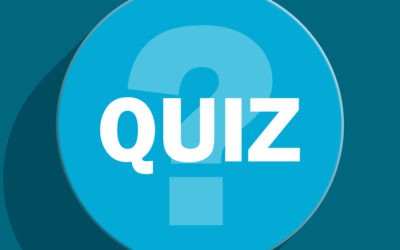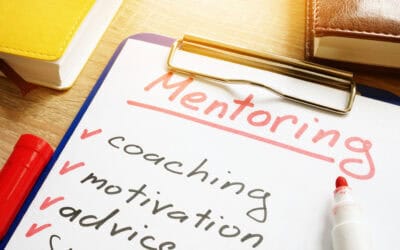
Pat Dobie teaches a comprehensive course on developmental editing for fiction.

Pat Dobie teaches a comprehensive course on developmental editing for fiction.
Updated: Sep 23, 2025
As a developmental editor of fiction for the last fifteen years, I’ve worked on over two hundred novels in just about every genre of fiction, both literary and commercial.
By chance, some of the writers I’ve worked with held day jobs as editors in other fields, such as academics or medicine. They knew a lot about fiction from having written a novel, and they knew a lot about editing from having worked in the field. Yet when they talked about developmental editing, they would say things like:
“I could never!”
or:
“I might branch out to copyediting fiction—but not doing all that you do with structure and plot … I’m not ready for that!”
Developmental Editing, Demystified
It’s true that even simple novels are complicated. And it’s true that a well-honed reading sensibility and a solid grounding in the mechanics of storytelling and prose will be extremely useful to any editor of fiction.
But it’s not true that developmental editing requires mastery of the art of fiction. Beginner and intermediate editors can serve fiction writers, too. And you don’t need an MFA in writing or a Ph.D. in literature to be a successful developmental editor of fiction. All the skills you need can be learned through classes like this one.
I believe there has never been a bigger demand for good developmental editors, and over the last fifteen years as an editor and a lifetime as a writer, I’ve learned what works and what doesn’t work—for both me and the writers I work with. I’ve heard horror stories from writers about previous experiences with freelance editors, and I’ve seen just how profoundly life-changing a good developmental edit can be.
All this is why I’m working with Editorial Arts Academy to offer this one-of-a-kind course on developmental editing of fiction.
If you’re ready to take the plunge into working with fiction writers, here’s more information about the course.
Developmental Editing for Fiction: A Step-by-Step, Experiential Class
Over the years I have learned how to take a book-length fiction manuscript and unpack its inner workings, guiding the writer how to amplify their story’s strengths, improve its weaknesses, and bring it to a higher level.
In this course, I share:
- the steps involved in analyzing a fiction manuscript at the big-picture level
- the main tools used in a novel’s developmental edit and how to employ them
- the essentials of how to attract and retain the writers you want to work with
This course teaches you how to get under a novel’s hood and see where its story engine is faltering. It gives you resources and basic grounding in literary craft and in the fiction-publishing landscape, so you can give the writer confidence that your opinion means something. And it shows you how to communicate your findings and recommendations in a way that motivates the writer to do better, come back to you with future work, and recommend you to other writers.
The Fiction Writer’s Hope
On the surface, fiction writers work with developmental editors to improve one particular manuscript, usually so they can get an agent and ultimately a publishing contract, or so they can self-publish a novel they’re proud of.
But behind this one manuscript is an entire world of motivations and experiences with the publishing industry—some good, some bad.
We all know that without writers, there is no publishing industry. I don’t think it’s overstating the case to say that a good developmental edit can change a writer’s life for the better, and a bad one can wreak havoc. I’ve worked with writers who’ve almost given up on a novel because of a bad experience with a freelance editor. They’ve said things like:
“I had an editor for the same manuscript several years ago, but I ended up discouraged and put it away.”
Or:
“I paid [another editor] thousands of dollars for a developmental edit but I got a thin-as-dishwater copyedit lite.”
Or:
“They kept my manuscript for a year and when I got it back, they had introduced errors and rewritten whole sections.”
So in this course, I not only cover what to do in a developmental edit of a fiction manuscript, but also go over what not to do.
How This Developmental Editing Course Differs from Others
I believe in “learn by doing.” That’s partly how I learned to developmentally edit fiction myself.
So that you can learn by doing, we use a complete, unpublished novel manuscript to walk through all the steps of a developmental edit.
There is no other course I’m aware of that takes you through this process step by step, using an entire manuscript (except possibly for masters programs in publishing that include “editing” as a course offering).
For several years, I taught this course “live” (on Zoom) over a six-week period. We used a novella manuscript so that students would have time to do the entire process from start to finish. This was effective, since the process is the same regardless of MS length. With each cohort, I refined the material and made the course more robust.
In 2025, I expanded the course to nine weeks. This allows us to use a full-length novel, and gives us more time to “workshop” the edit with each other. The course is now semi-synchronous, with two Q&A sessions and a 24/7 forum on Circle. I also offer (as a separate add-on) personal feedback on the three deliverables of a developmental edit: your manuscript comments, book map, and editorial letter.
Course Promise
Developmental Editing for Fiction will give you everything you need to know to hang out your shingle as a developmental editor of fiction.
Developmental Editing for Fiction: Take the Tour
Week 1: Who are Developmental Editors, Anyway?
- Lesson 1.1: “A Short Tour of the Publishing Landscape”—We dive right into who’s hiring freelance developmental editors and where we fit in a fiction writer’s career trajectory.
- Lesson 1.2: “A Sample Trajectory to Developmental Editing”—I describe how and why I became a developmental editor, how my business grew, and what types of projects and clients I work with in any given six-month period.
- Lesson 1.3: “Making Space for the Project”—We preview the course, go over what you’re expected to do over the next nine weeks, and clarify what kind of feedback you will receive, if you choose to purchase the feedback add-on.
- Lesson 1.4: “Your Reading History & Why it Matters”—Why this course, why now? What do you see as your strengths and weaknesses going in? We talk about the reading sensibility, how much you need to know about the craft of writing fiction, and how to evaluate and begin filling holes in your background.
⇒ Homework: Self-assessment, blocking time for the coursework, readings from assigned texts, sign and return Non-Disclosure Agreement (NDA).
Week 2: What to Learn Before You Start
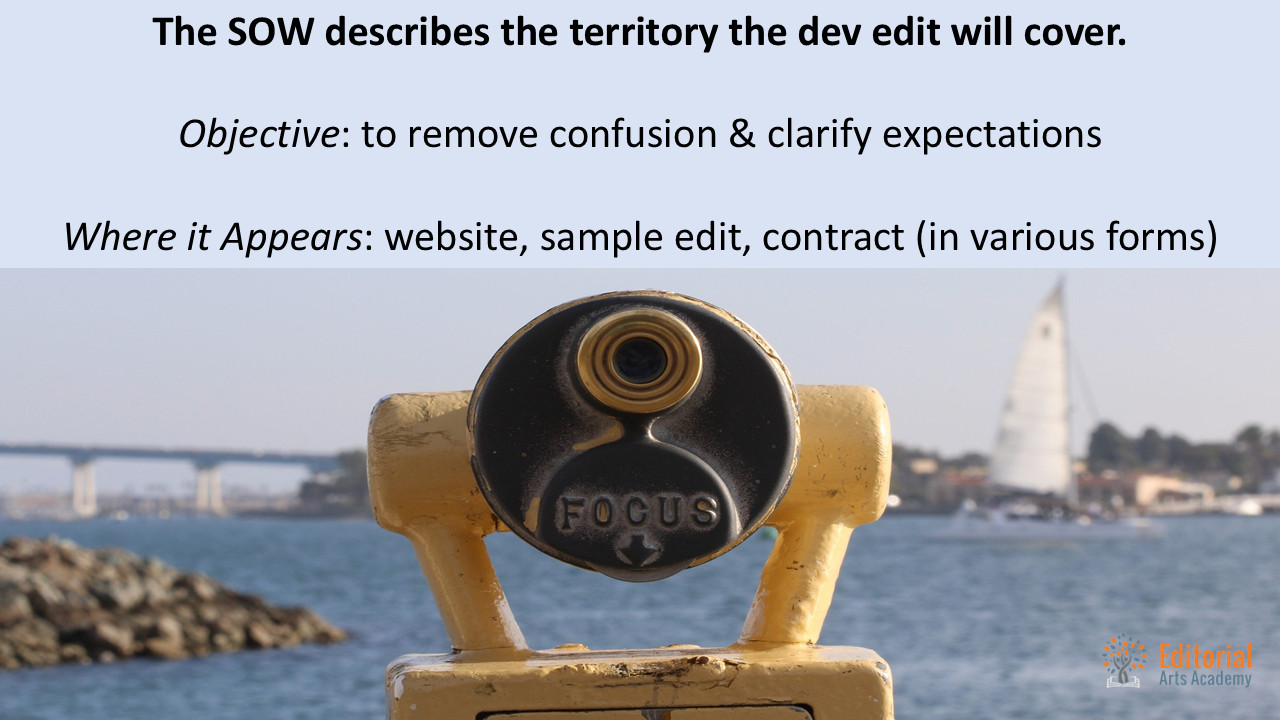
Slide from Lesson 2.3, “The Developmental Edit Scope of Work”
- Lesson 2.1: “The Developmental Edit Scope of Work”—We focus on the specific task at hand, the scope of work for a developmental edit. You will see my scope of work and will begin the process of learning how to write your own.
- Lesson 2.2: “The Five Stages of a Developmental Edit”—I describe the stages of a developmental edit. We follow these five stages throughout the course.
- Lesson 2.3: “The Fundamental Tools of the Developmental Edit”—I introduce manuscript markup, the book map, the editorial letter, and the fourth tool, a follow-up video meeting with the writer. I show you examples of the first three and explain why the fourth matters so much.
- Lesson 2.4: “Getting Started”—I release the MS to students who have signed and returned the course NDA, explain how to prepare the manuscript, and discuss how to set yourself up for a successful edit.
⇒ Homework: Prepare manuscript for edit, read & comment on first 20 pages; readings from assigned texts
Week 3: Capturing Your Reading Experience
- Lesson 3.1: “Craft Elements #1”—This is a developmental overview of craft elements you can assess on your first read of the manuscript: characterization, point of view, scene dynamics, world building, and narrative modes.
- Lesson 3.2: “Active Reading”—We go over what active reading looks like and how to bring your reading sensibility to the fore, so you can fully absorb the novel and reflect your reading experience back to the author.
- Lesson 3.3: “Principles of Developmental Commentary”—We talk about how to convey your reading experience via marginal comments without needlessly killing the writer’s spirit or jeopardizing their willingness to revise.
- Lesson 3.3: “Time Management Ideas”—I introduce the systems I use to deliver edits on deadline and on budget.
⇒ Homework: Get halfway through MS with marginal comments; readings from optional texts
Week 4: Gathering Context as You Work
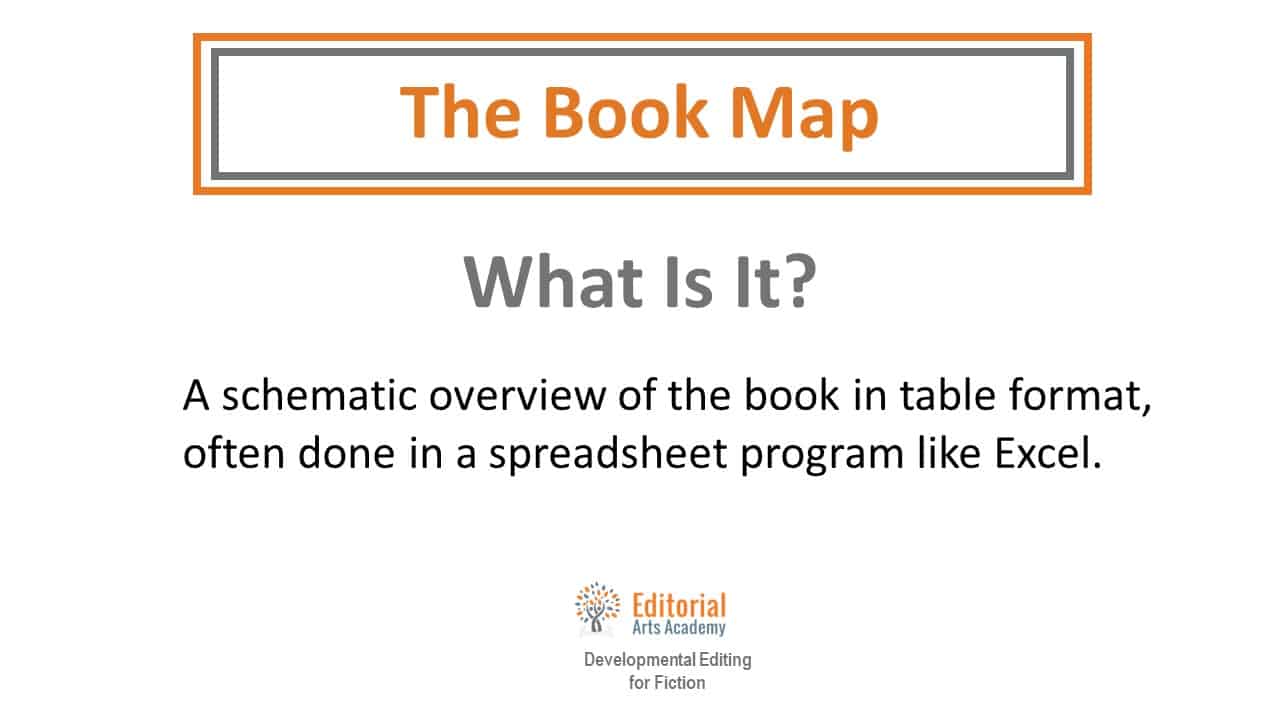
Slide from Lesson 4.2, “The Book Map: A Preview”
- Lesson 4.1: “Manuscript Evaluation vs. Developmental Edit”—Many editors offer more than one type of big-picture service. This lesson discusses the difference between the two and explains why I offer both.
- Lesson 4.2: “The Book Map: A Preview”—This lesson begins to familiarize you with the book map by describing what it is, why they are so useful for developmental editors, and how long they take.
- Lesson 4.3: “Fiction Craft Elements #2”—This is a developmental overview of craft elements you will analyze when doing a book map: dramatic structure, plot, the story engine, and the cause-and-effect chain (all interrelated).
⇒ Homework: Complete reading MS w/ comments [optional add-on: submit MS for instructor feedback]
Week 5: Creating a Book Map
- Lesson 5.1: “Book Mapping, Step by Step”—We go through how to create a book map for the novel manuscript, showing you how to unpack the story’s plot, structure, pacing, and other important big-picture elements.
- Lesson 5.2: “How to Analyze Book Maps”—I describe how to review and analyze the book map by asking yourself specific questions. This allows you to develop an informed view of the novel’s major strengths and weaknesses on the level of plot, structure, and story engine.
- Lesson 5.3: “Fiction Craft Elements #3”—This is a developmental overview of craft elements that require deep analysis and can make or break the reading experience: concept, premise, theme, and stakes.
⇒ Homework: Begin creating a book map for the course novel; readings from optional texts
Week 6: Making Sense of Your Findings
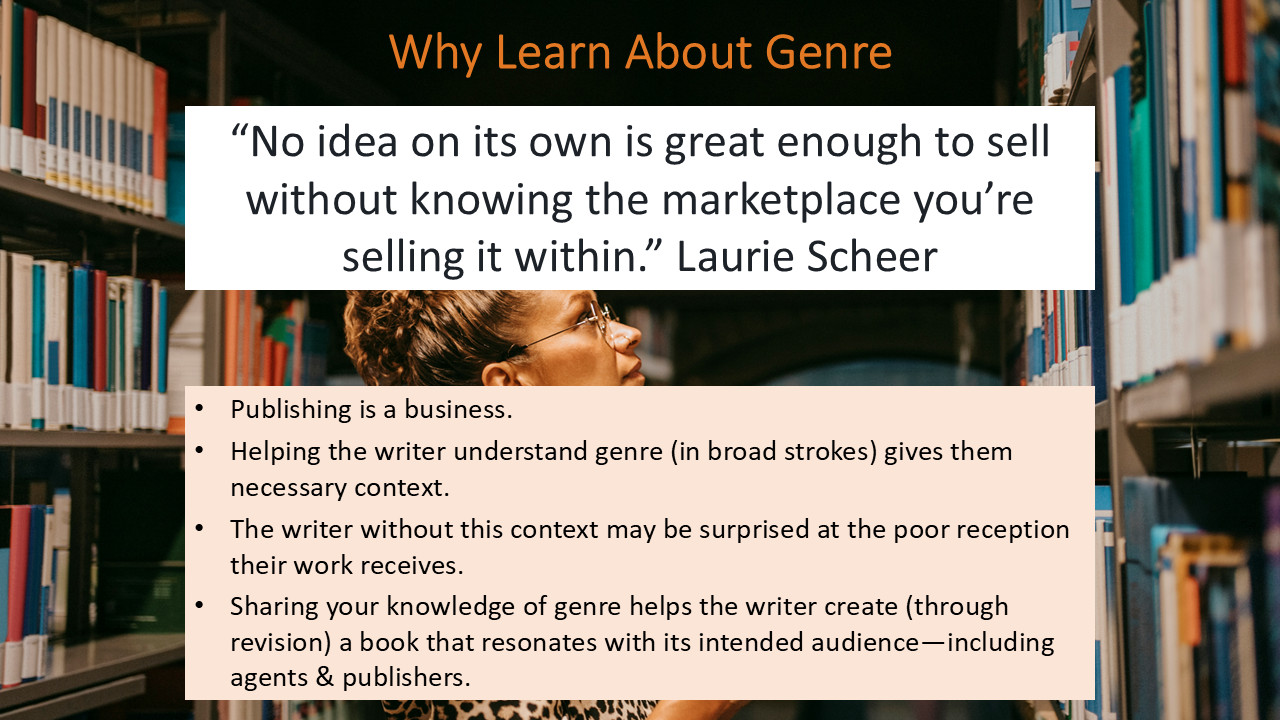
Slide from Lesson 6.1, “Fiction Craft Elements #4: Genre”
- Lesson 6.1: “Genre Considerations in Craft”—This is a developmental overview of how to research, assess, and understand whether any given manuscript meets reader expectations in terms of genre and publishing category.
- Lesson 6.2: “Identifying Strengths & Weaknesses, Part 1”—The last five weeks have prepared you for the task of identifying the course novel’s major strengths and weaknesses. In this lesson, we look at how to begin gathering and analyzing your material with the goal of writing a strong editorial letter.
- Lesson 6.3: “Why the Editorial Letter is Crucial”—We look at how editorial letters create the gateway to the developmental editing experience for the writer.
⇒ Homework: Complete book map; begin identifying the novel’s strengths & weaknesses [optional add-on: submit book map for feedback]
Week 7: Writing the Editorial Letter

Slide from Lesson 7.1, “Various Editorial Letter Approaches”
- Lesson 7.1: “Various Editorial Letter Approaches”—Every editor has their own style and approach to editorial letters. This lesson looks at a few different ways of delivering big-picture feedback via an editorial letter or report.
- Lesson 7.2: “Identifying Strengths & Weaknesses, Part 2”—This continues the process of analysis you began last week, with a focus on turning your analysis of the novel into feedback the writer can absorb and act on.
- Lesson 7.3: “Seven Steps to a Powerful Editorial Letter”—How to craft a strong editorial letter. The importance of the unvarnished truth. How to convey strengths and weaknesses in a way that leaves the writer motivated to engage in revision.
⇒ Homework: Homework: Write the Editorial Letter
Week 8: Delivering Your Developmental Edit
- Lesson 8.1: “The Must-Haves for a Professional Edit”—How to review, revise, polish, and deliver a professional edit every time.
- Lesson 8.2: “Post-Edit Services”—The importance of followup in creating a strong relationship with every writer you work with, resulting in return clients and a steady flow of work.
- Lesson 8.3: “Scope Creep & How to Manage It”—What scope creep can look like in developmental edits, how to prevent it, and what to do if it happens.
⇒ Homework: Homework: Email Your entire Developmental Edit to the Instructor [optional add-on: submit editorial letter for feedback]
Week 9: Hanging Out Your Shingle
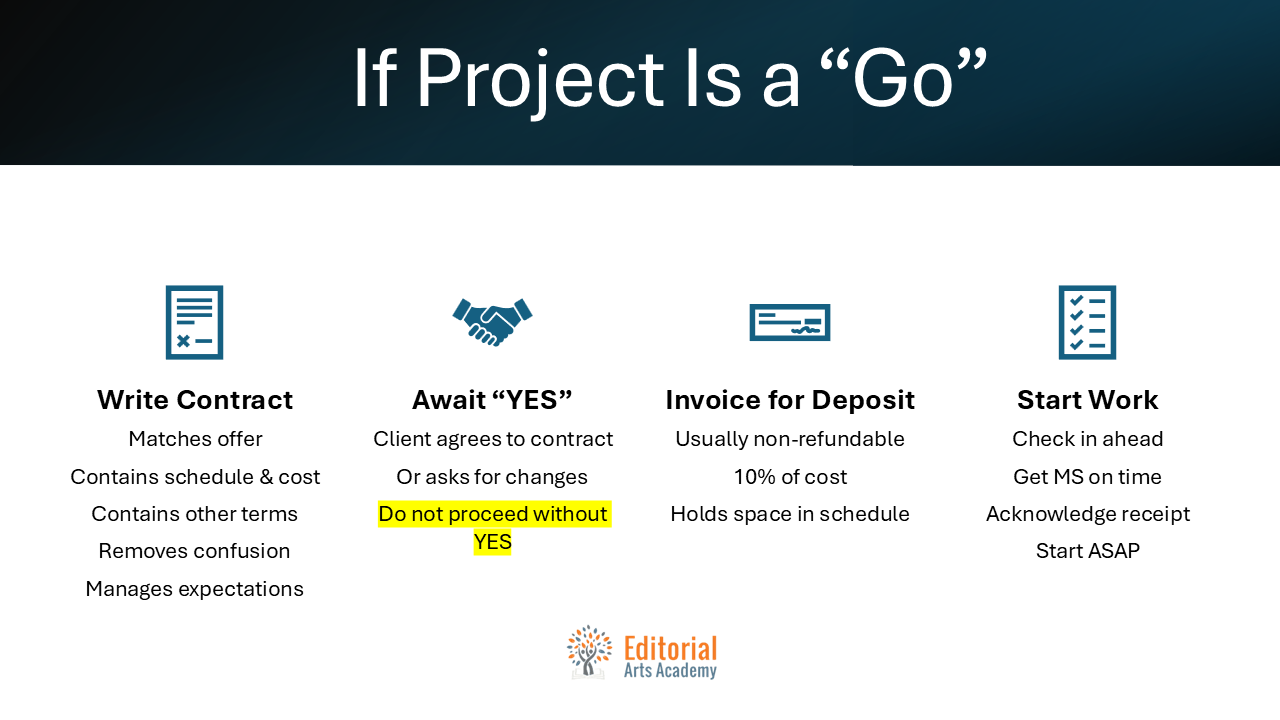
Slide from Lesson 9.1, “Onboarding Clients”
- Lesson 9.1: “Onboarding Clients”—We discuss how to use sample edits and contracts to check “fit” and ensure that you and the client have the same understanding of what you will provide.
- Lesson 9.2: “Professionalism and Systems”—This lesson goes over the fundamentals of a solid developmental editing practice and how to build trust with new clients. We discuss how to manage expectations and go through the essential systems you will need to give the writer a good experience without burning out.
- Lesson 9.3: “Your Career Trajectory”—Advanced skills come with experience, and the sooner you hang out your shingle, the sooner you’ll start getting the experience you need. In this final lesson of the course, we go back to who you are and what you’ve learned, and give you tools to design your trajectory.


